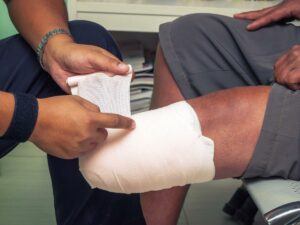Your immune system usually does a great job of defending against harmful foreign substances like bacteria and viruses. However, it sometimes reacts to substances that do not pose a real threat. It can also overreact to certain conditions, putting your body in a state of shock.
These unnecessary responses are known as allergic reactions and can be extremely serious – even fatal! When they occur, a quick response is often required, so knowing the correct first aid for allergic reactions can be truly lifesaving.
What can cause an allergic reaction?
Exact rates are difficult to measure but it’s believed approximately 20% of Australians have some kind of allergy. It is not clear why some people develop allergies, or why they react to the specific substances (allergens) they do. While anything you come in contact with could be an allergen, reactions to certain substances are more common, including:
- Environmental substances, like pollen, pet dander, and mould
- Certain foods, like dairy, nuts, seafood, and gluten
- Insect bites and bee stings
- Certain medications, like some anti-inflammatory and antibiotic drugs
What are the symptoms of an allergic reaction?
How an allergic reaction presents will depend on the type of allergen and severity of the reaction. For example, environmental allergens often result in sneezing, shortness of breath, and watery eyes, particularly if the allergen is inhaled. Whereas food allergens are generally ingested, so they often cause hives and rashes, as well as vomiting and diarrhoea.
Severe reactions (anaphylaxis)
In extreme cases, an allergic reaction can cause anaphylaxis, which can occur within minutes of exposure to the allergen. Signs and symptoms of anaphylaxis include:
- Difficult or noisy breathing
- Swelling of tongue
- Swelling or tightness in the throat
- Wheeze or persistent cough
- Difficulty talking or hoarse voice
- Persistent dizziness or collapse
- Pale and floppy (young children)
If someone is experiencing anaphylaxis, immediate treatment is required to prevent the condition from developing further. Left untreated, anaphylaxis can cause respiratory distress, a loss of consciousness, and cardiac arrest.
Providing first aid for allergic reactions
How you should respond to an allergic reaction will depend on its severity.
Most mild reactions will resolve themselves, usually within a few hours, and do not require professional medical attention. If the reaction was caused by contact, washing the area with soap and lukewarm water can help speed up this process. Depending on the type of reaction, antihistamines or anti-inflammatory medication can also help manage the symptoms.
If the reaction is severe and there are signs of anaphylaxis, immediate medical attention is required.
- Call 000
You should always call an ambulance if a person is presenting with signs of a severe allergic reaction. If possible, it is best to get someone else to do this while you begin administering treatment.
- Lay the person flat
Anaphylaxis can cause blood pressure to drop rapidly. Getting the person to lie down will help combat this by improving blood flow to the heart. If the person is having trouble breathing, they can sit up, but do not allow them to stand or move around.
- Administer treatment
Attempt to locate the patient’s ANAPHYLAXIS ACTION PLAN or FIRST AID PLAN FOR ANAPHYLAXIS and follow the steps shown on it. If there is an autoinjector such as an EPIPEN or ANAPEN available, it should be used as per the instructions on the device and on the ACTION PLAN / FIRST AID MANAGEMENT PLAN FOR ANAPHYLAXIS.
Some first aiders adopt a conservative approach to treatment and prefer to administer antihistamines in the first instance. While this can help manage the symptoms of an allergic reaction, it will not have an impact on anaphylaxis.
What’s more, it can delay the administration of an EPIPEN / ANAPEN, which can significantly increase the risk of more serious health outcomes.
If the person is known to have asthma and they are having trouble breathing, they should also use their reliever puffer. However, this should be done after the EPIPEN / ANAPEN has been administered.
- Monitor their condition
Once the EPIPEN / ANAPENe has been administered, it should begin to provide relief within minutes. If the person remains unresponsive, further EPIPENS / ANAPENS can be administered every 5 minutes AS PER THE PATIENTS ACTION PLAN or the First Aid Plan for ANAPHYLAXIS.
Even if the person starts to show signs of improvement, keep them flat and still until the ambulance arrives. If they begin to vomit, turn them on their side to reduce the risk of aspiration. If they stop breathing, begin CPR.
Knowing what to do could save a life
If you or someone you know experiences severe allergic reactions, you need to be prepared to respond quickly. This includes making sure you have an EpiPen with you at all times and knowing how to provide proper first aid for allergic reactions. To learn exactly what to do in this, and many other, situations, sign up for one of our first aid courses.






